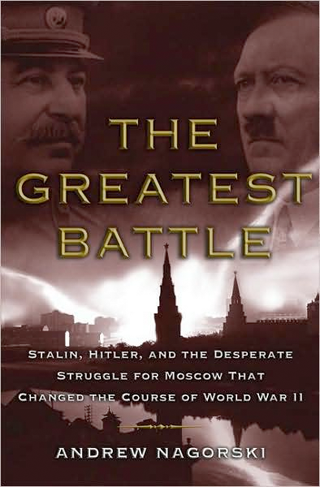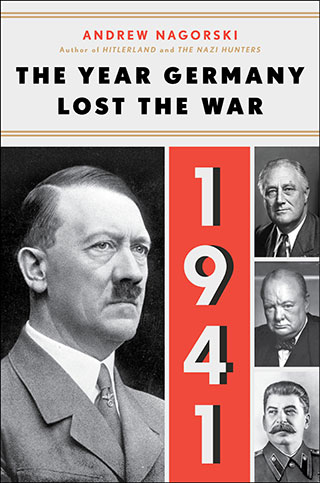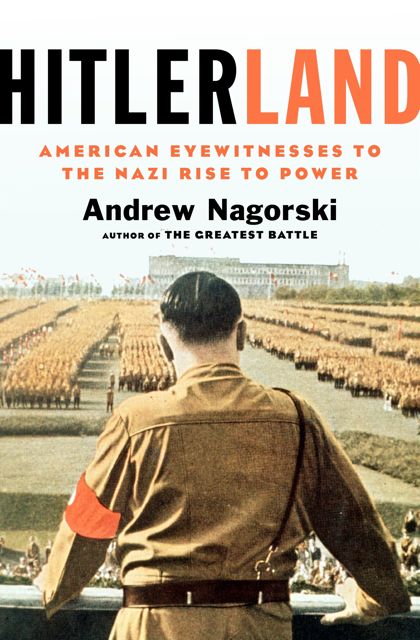A Review of “Hitlerland: American Eyewitnesses to the Nazi Rise to Power”
The tale of Hitler’s rise to power still strikes many of us as an anomaly. How could such a man have taken control of a modern, civilized nation and led it over the precipice of total war? Even after he became Germany’s Chancellor, the coup that allowed him to seize dictatorial powers, many continued to regard Hitler as a buffoon. Perhaps even more catastrophic was the belief that he could be accommodated, which led British Prime Minister Neville Chamberlain to give him the green light to invade Czechoslovakia. Although there were certainly those who understood the threat Hitler represented, too many continued to believe that the pragmatism of the German people would prevail.
Andrew Nagorski's absorbing new book, Hitlerland: American Eyewitnesses to the Nazi Rise to Power, tells the story of Hitler’s career from the end of World War I till his declaration of war on the United States through the eyes of the American diplomats, journalists, and tourists who watched it happen at close range. Some of these individuals either were, or became, household names in the United States: among many others, they included Ben Hecht, the famed screenwriter and Hollywood icon; Howard K. Smith, later famous as a television news anchorman; Martha Dodd, daughter of the Berlin envoy; the famous autobiographical novelist Thomas Wolfe; Sinclair Lewis, the Nobel-Prize-winning novelist, and his wife, journalist Dorothy Thompson; W. E. B. DuBois, the brilliant African-American scholar; Olympic legend Jesse Owens; Charles Lindbergh, the noted aviator; and William L. Shirer, famed author of Berlin Diary and The Rise and Fall of the Third Reich. A sampling of some of these individuals’ stories will give an idea of what Nagorski’s book seeks to accomplish.
Ben Hecht
Source: Wikimedia Commons
As early as 1918, Ben Hecht saw that something was seriously amiss as a virtually unpiloted Germany struggled to control runaway inflation and a wild, deeply divided society. The situation would not improve markedly with the foundation of the Weimar Republic the following year, although inflation would eventually be brought more or less under control. This was the world that expatriate writer Christopher Isherwood depicted in stories that would later form the basis for the hit Broadway musical Cabaret. An anything-goes atmosphere predominated. “Germany is having a nervous breakdown,” wrote Hecht, then a young reporter for theChicago Daily News. “There is nothing sane to report.”
It was this world that Hitler promised to reform with his program of iron discipline and authoritarianism. It is, perhaps, not difficult to understand why many saw Hitler’s prescription as just what Germany needed. He was able to systematize and consolidate his ideas during his short, comfortable stint in Landsberg Prison after the abortive “Beer Hall Putsch” of 1923, in which he made a premature attempt to seize power. Hitler himself nearly died twice during this episode. The first brush with death occurred when the man marching arm-in-arm with him was shot dead. The second came after it was clear that the coup was a failure and Hitler, in a fit of despair, apparently intended to take his own life. According to one account, Helen Hanfstaengl, the American wife of Hitler’s Harvard-educated, half-American-half-German propagandist, Ernst “Putzi” Hanfstaengl, foiled the attempt by snatching the gun from his hand. “What if?” is a question that arises again and again in Nagorski’s book.
Ernst "Putzi" Hanfstaengl
Source: Wikimedia Commons
Howard K. Smith
Source: Wikimedia Commons
It is clear that, along with other German citizens, many of Hitler’s most devoted followers failed to take him as seriously as they should have. Putzi Hanfstaengl, who, like Hitler, was often mistakenly perceived as an innocuous, clown-like figure, seemed to understand that Hitler was an aberrant individual, both mentally and physically. According to Putzi, “I felt Hitler was a case of a man who was neither fish, flesh nor fowl, neither fully homosexual nor fully heterosexual... I had formed the firm conviction that he was impotent, the repressed, masturbating type.” Nevertheless, in a 1973 interview conducted when he was eighty-eight years old, Putzi confided that Hitler was “still in his bones.”
Germany itself was often seen as a model for humanity before the truth of the transformations that were reshaping it became apparent. Howard K. Smith delineated a process of growing awareness that new visitors to Germany went through as they passed from a state of admiration to one of fear and loathing. Smith wrote that “Germany was clean, it was neat, a truly handsome land. Its big cities were cleaner than big cities ought, by custom, to be... The impression was one of order, cleanliness and prosperity,” which was “of immense propaganda value to the Nazis.” Perhaps even more influential, particularly when it came to gregarious American tourists, was the Germans’ open-handed, cheerful friendliness. Only over time, wrote Smith, did one grow aware of the truth of the matter, that Germany was arming itself mentally and physically for conquest.
There are many fascinating stories of the individuals who confronted Hitler and Nazism in the 1920s and 1930s and were seduced, horrified, or both. One that permeates a good many pages of Nagorski’s book is that of Martha Dodd, daughter of Berlin envoy William E. Dodd, who took his post in 1933, the year Hitler took control of Germany. Martha, well-known as a party girl, was seduced by the high circles in which she moved and was pro-Nazi for a good while before becoming pro-Stalinist. In one bizarre episode, Putzi Hanfstaengl introduced her to Hitler himself, telling her that “Hitler should have an American woman—a lovely woman could change the whole destiny of Europe.... Martha, you are the woman!” Martha’s impression was favorable, and she recalled Hitler’s eyes, which were “startling and unforgettable—they seemed pale blue in color, were intense, unwavering, hypnotic.”
Thomas Wolfe
Source: Wikimedia Commons
Sinclair Lewis and Dorothy Thompson
Source: Wikimedia Commons
W. E. B. DuBois
Source: Wikimedia Commons
Charles Lindbergh
Source: Wikimedia Commons
One of Martha’s paramours, the American novelist Thomas Wolfe, author of Look Homeward, Angel, was also temporarily seduced by the allure of the new Germany, although his infatuation may be a bit more understandable than Martha’s. Wolfe’s work was wildly popular among the German people, who bought his books by the train-load, and Wolfe, naturally appreciating their excellent taste, returned their warm feelings. Wolfe, however, eventually understood the direction Germany was headed and wrote a short novel illustrating his views, I Have a Thing to Tell You, later incorporated into his novel You Can’t Go Home Again. When the story was published his books were banned in Germany, ending the love affair.
Another American novelist who saw the dangers of fascism was Sinclair Lewis; his views were shared by his wife, the prominent journalist Dorothy Thompson. In 1935 Lewis put his fears in writing, dashing off a novel about the rise of fascism in America, It Can’t Happen Here, in a mere eight weeks. Like many of Lewis’s other books, it was wildly popular. It is relevant today more as a social and historical document than as literature.
One of the most famous episodes of prewar Nazi Germany was, of course, the 1936 Olympics, in which African-American track and field star Jesse Owens made his mark, winning four gold medals. Nagorski reveals that “while Hitler and other top Nazis bitterly complained about the black American Olympians, some of those athletes were invited by ordinary German citizens for coffee or dinner.” It is sobering indeed to read the words of American scholar W. E. B. DuBois, who explained Owens’s and other black athletes’ low-key response to Nazi racism: “I have been treated with uniform courtesy and consideration,” DuBois wrote. “It would have been impossible for me to have spent a similarly long time in any part of the United States, without some, if not frequent cases of personal insult or discrimination.. I cannot record a single instance here.” Dubois’s words are, of course, not an endorsement of the Nazis but an indictment of American race relations.
Another source of controversy arising from American attitudes and accommodation of the Nazi program is the case of Charles Lindbergh, the famous aviator. Lindbergh, who was outspoken in his belief that the United States should stay out of the European war, has been denigrated as a Nazi sympathizer. Nagorski suggests, however, that Lindbergh’s “softness” on Hitler “only confirmed how well he had been played by the Nazis.” Nevertheless, Lindbergh’s statements often seem compromising in other ways. Consider, for example, his statement regarding the possibility of war between Germany and the Soviet Union: “a victory by Germany’s European people would be preferable to one by Russia’s semi-Asiatic Soviet Union.”
William L. Shirer in 1961
Source: Wikimedia Commons
One American who understood the threat Hitler represented from the beginning and made no secret of his views was journalist and historian William L. Shirer. In many respects Shirer emerges as the hero of Nagorski’s account. His uncompromising reporting exposed him to progressively more censorship and physical danger throughout his tenure in Nazi Germany. Nevertheless, he stayed until December 1940, then smuggled out the voluminous notes for his first-person account of Hitler’s rise to power,Berlin Diary. In later years Shirer published The Rise and Fall of the Third Reich, still regarded by many as the best all-around history of Hitler’s Germany.
Nagorski's book features a large cast of characters, some of whom appear once and then drop out of sight and some who appear repeatedly. He presents his story in chronological order, as one would expect, and it reads like a novel, its prose distinguished mainly by fluidity and straightforwardness. Since many characters appear, drop out of sight, then reappear again, some repetition is inevitable, but this is kept to a minimum and does not delay the reader for long. All in all, Nagorski’s narrative is a fascinating one and well worth reading.








